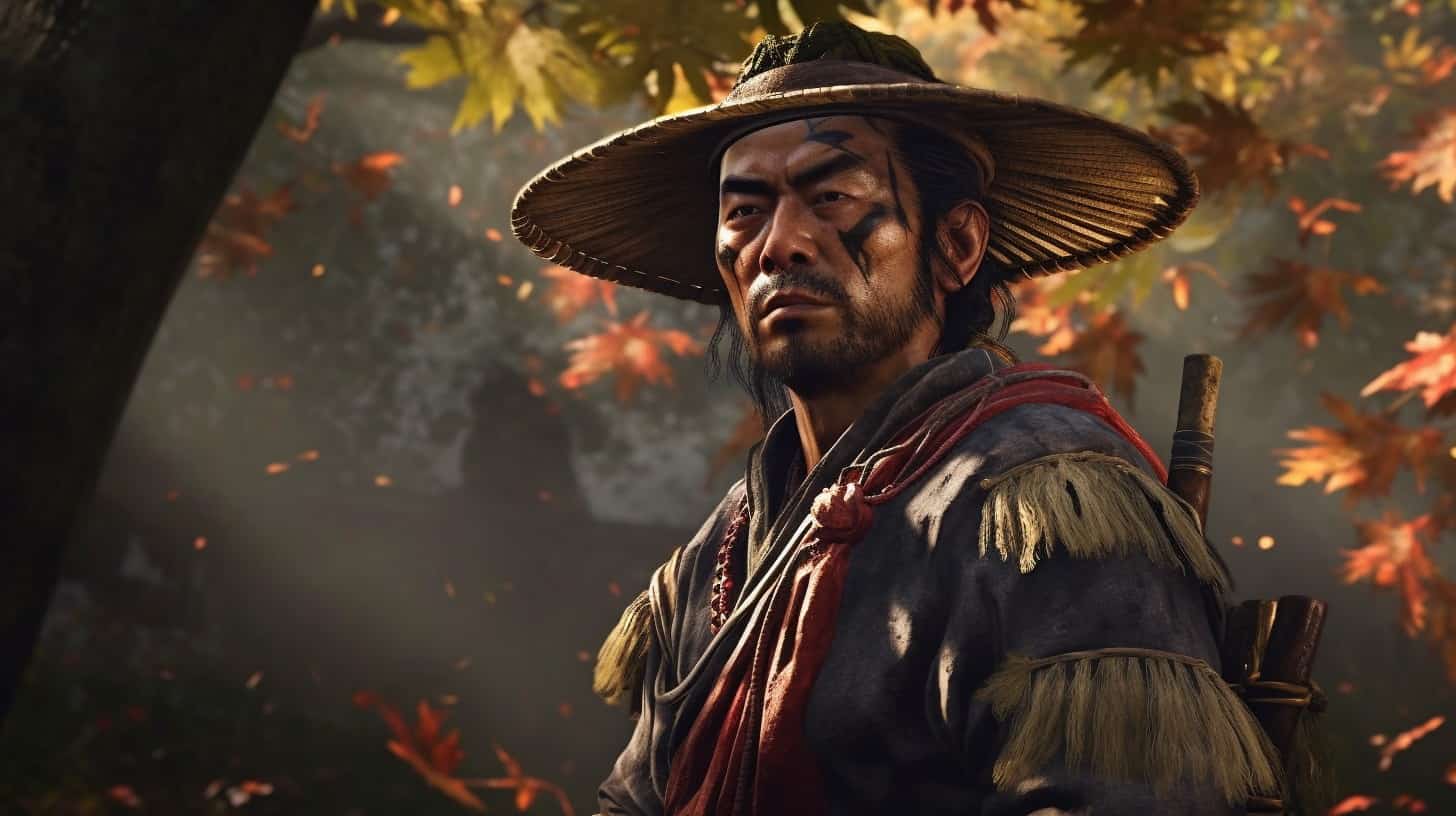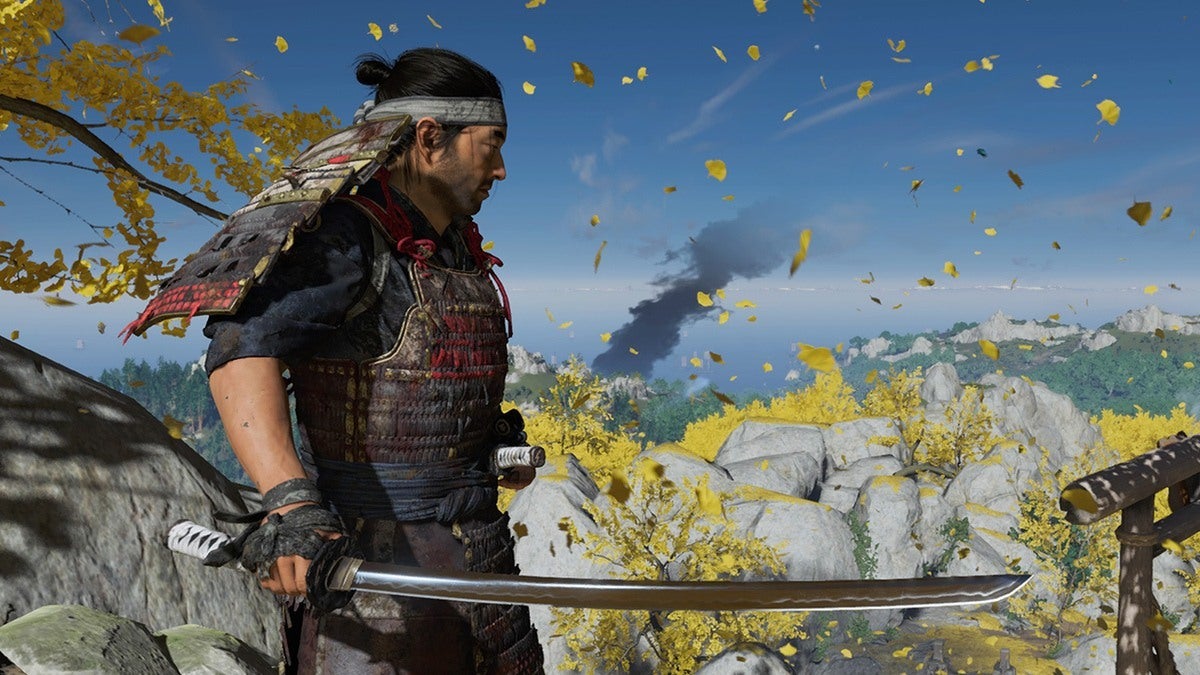1. Introduction
In the lush, sprawling landscapes of Tsushima Island, where the serene beauty of nature collides with the brutal realities of war, lies the heart of “Ghost of Tsushima,” an action-adventure game that has captivated the imaginations of players around the globe. Developed by Sucker Punch Productions and released in July 2020, this game not only offers an immersive open-world experience but also serves as a profound exploration of samurai culture, honor, and the sacrifices of war. It is a narrative that delves deep into the soul of its protagonist, Jin Sakai, a samurai warrior faced with the daunting task of protecting his homeland from the formidable Mongol invasion of the 13th century.
“Ghost of Tsushima” is more than just a game; it is a bridge between the past and the present, inviting players to step into the shoes of a samurai, to live by the sword, and to confront the complexities of duty versus personal conviction. This document aims to provide a comprehensive deep dive into the various facets that make “Ghost of Tsushima” a remarkable piece of interactive entertainment. From its historical backdrop, which draws inspiration from real events and locations, to the intricate depiction of samurai culture and traditions, the game is a rich tapestry of historical and cultural references that enrich the player’s experience.
Furthermore, the game mechanics and design invite players to explore the breathtaking landscapes of Tsushima, engage in meticulously crafted combat, and navigate a story of betrayal, sacrifice, and redemption. The narrative and character development are central to the game’s impact, offering a window into the internal struggles and moral dilemmas faced by those who lived through this tumultuous period in history.
The artistic direction and sound design of “Ghost of Tsushima” are pivotal in bringing the world of feudal Japan to life, with stunning visuals and a hauntingly beautiful soundtrack that complements the emotional depth of the story. Lastly, the cultural significance and reception of the game highlight its impact not only within the gaming community but also in how it has been received by Japanese audiences, reflecting a respectful and thoughtful portrayal of Japan’s rich history and traditions.
As we embark on this journey through the heart of the samurai, “Ghost of Tsushima: A Deep Dive into the Heart of the Samurai” aims to provide fans, newcomers, gamers, history enthusiasts, and cultural scholars with a thorough understanding of the game’s development, narrative depth, and cultural significance. This document is an invitation to explore the layers of meaning behind one of the most compelling video games of our time, offering insights into its creation and the lasting impact it has had on its audience.
2. The Historical Backdrop
2.1. The Real Tsushima Island: Geography and Strategic Importance
Tsushima Island, nestled in the straits between the Japanese archipelago and the Korean Peninsula, is a place of both breathtaking natural beauty and significant historical importance. The island serves as a crucial geographical marker in East Asia, acting as a bridge that historically connected Japan with the cultures of mainland Asia. Its strategic location made Tsushima not just a hub for cultural exchange but also a key defensive point for Japan against potential invasions.
Geographically, Tsushima is part of Nagasaki Prefecture and is composed of over 100 smaller islands, with the two main islands being connected by the Tsushima Strait. The island’s terrain is predominantly mountainous, covered with dense forests that have historically provided both resources and natural defense mechanisms. The surrounding seas are rich in marine life, making fishing a vital part of the local economy for centuries.
The strategic importance of Tsushima cannot be overstated. Throughout history, it has been the first line of defense against invasions from the Korean Peninsula and mainland China. Its proximity to the Korean Peninsula, roughly 50 kilometers at its closest point, made it an ideal staging ground for trade and diplomatic missions between Japan, Korea, and China. This unique position allowed Tsushima to flourish as a center of international trade during periods of both peace and conflict.
During the feudal era of Japan, the island was governed by the Tsushima Fuchū domain, which played a crucial role in managing foreign relations, especially with Korea. The So clan, the ruling family of the domain, were instrumental in these diplomatic efforts, leveraging Tsushima’s strategic position to facilitate trade and diplomacy, while also preparing for the defense of Japan.
The historical significance of Tsushima was highlighted during the Mongol invasions of Japan in the 13th century, particularly the first invasion in 1274. As the Mongol forces advanced towards Japan, Tsushima was one of the first places to face the onslaught. The island’s defenders, vastly outnumbered, fought valiantly against the invaders, showcasing the strategic importance of Tsushima in Japan’s maritime defense. This event underscored the island’s role not just as a commercial hub but as a critical point of military defense against external threats.
In modern times, Tsushima continues to be recognized for its natural beauty and historical sites, attracting tourists interested in its rich history and unique culture. The island’s strategic importance has evolved, but its legacy as a bridge between nations and cultures remains a pivotal aspect of its identity.
2.2. The Mongol Invasion of 1274: Historical Facts vs. Game Fiction
The Mongol invasion of Tsushima Island in 1274 serves as the historical backdrop for the video game “Ghost of Tsushima.” This event marks a pivotal moment in Japanese history, where the Mongol Empire, under the leadership of Kublai Khan, sought to extend its dominion over Japan. The game intricately weaves this historical event into its narrative, blending fact with fiction to create a compelling story. To appreciate the depth of the game’s setting, it’s essential to distinguish between the historical facts of the invasion and the liberties taken by the game’s creators.
Historical Facts
The Mongol invasion of 1274 was part of Kublai Khan’s larger ambition to subjugate Japan. The Mongol forces first targeted Tsushima Island due to its strategic location between Korea and the Japanese mainland. Historical records indicate that the Mongols launched their attack with a sizable fleet, carrying thousands of soldiers, which included Mongol, Chinese, and Korean warriors. The defenders of Tsushima, vastly outnumbered, faced a brutal onslaught. The historical accounts detail a grim fate for the island’s inhabitants, with many being killed or taken as prisoners. The Mongol forces then proceeded to the Japanese mainland, where adverse weather conditions and staunch Japanese defense eventually led to their withdrawal.
Game Fiction
“Ghost of Tsushima” takes creative liberties with this historical event to craft its narrative. The game focuses on Jin Sakai, a fictional samurai lord of Tsushima, who survives the Mongol invasion and embarks on a quest to repel the invaders from his homeland. The game portrays Jin’s transformation from a traditional samurai adhering to the Bushido code to the “Ghost,” a figure who employs unconventional warfare tactics. This character arc, while compelling, is a fictional narrative device designed to explore themes of honor, sacrifice, and adaptation in the face of overwhelming odds.
The game also amplifies the scale and impact of the Mongol invasion on Tsushima for dramatic effect. While the historical invasion was indeed devastating, the game depicts Tsushima as the central battleground for the defense of Japan, focusing on Jin’s guerrilla warfare tactics against the Mongol forces led by the fictional antagonist, Khotun Khan, purportedly a relative of Kublai Khan.
Conclusion
“Ghost of Tsushima” masterfully blends historical facts with fiction, using the Mongol invasion of 1274 as a canvas to tell a deeper story about honor, resilience, and transformation. While the game takes creative liberties in depicting the scale of the invasion, the characters involved, and the outcomes of various encounters, it does so to enrich the narrative and engage players in a deeply immersive experience. The game’s fictional elements are woven into the historical fabric with respect, aiming to honor the spirit of the samurai and the people of Tsushima who faced the Mongol threat.
3. Samurai Culture and Traditions
3.1. The Way of the Samurai: Bushido and Beyond
The samurai, Japan’s elite warrior class, have long captivated the imagination of people around the world, embodying the quintessence of honor, discipline, and martial prowess. At the heart of the samurai’s way of life was the code of Bushido, a term which translates to “the way of the warrior.” This code, although unwritten, was a set of moral principles that governed the life of a samurai, influencing every action, decision, and aspect of their daily life. “Ghost of Tsushima” delves deep into these principles, offering players not just a glimpse into the martial aspect of being a samurai, but also into the philosophical and ethical underpinnings of Bushido.
Bushido emphasized several virtues, including righteousness (義, gi), courage (勇, yū), benevolence (仁, jin), respect (礼, rei), honesty (誠, makoto), honor (名誉, meiyo), and loyalty (忠義, chūgi). These virtues were not merely abstract concepts but were expected to be manifested through the samurai’s actions and decisions. In “Ghost of Tsushima,” players experience these virtues through the protagonist, Jin Sakai, as he navigates the complexities of upholding his samurai honor while facing the brutal realities of the Mongol invasion.
The game intricately weaves the Bushido code into its narrative and gameplay mechanics. Players are constantly faced with choices that test their adherence to samurai ethics. For instance, the tension between the traditional samurai way of facing one’s enemy head-on and the stealth tactics Jin adopts (referred to as the “Ghost” tactics) mirrors the internal conflict between adhering to Bushido and adapting to the necessities of war. This duality not only adds depth to Jin’s character but also allows players to explore the flexibility and limitations of Bushido.
Beyond the battlefield, “Ghost of Tsushima” explores other aspects of samurai culture, such as tea ceremonies, haiku writing, and hot spring bathing, which serve as moments of reflection, relaxation, and connection to the broader cultural and natural landscape of feudal Japan. These activities, while offering a respite from combat, also deepen the player’s understanding of the samurai’s connection to art, nature, and spirituality.
The portrayal of samurai culture in “Ghost of Tsushima” extends beyond the glorification of warriors in battle to a more nuanced exploration of their roles as stewards of culture, art, and philosophy. The game presents a holistic view of the samurai, not just as warriors bound by a code of conduct, but as complex individuals navigating the challenges of loyalty, duty, and personal conviction in a time of crisis.
In essence, “Ghost of Tsushima” offers a rich, immersive experience into the way of the samurai, providing players with a deeper appreciation of Bushido and beyond. Through its narrative and gameplay, the game invites players to ponder the weight of the virtues that defined the samurai and to consider how these principles might apply in their own lives.
3.2. Armor, Weapons, and Warfare Techniques
The depiction of samurai culture in “Ghost of Tsushima” extends beyond the philosophical and into the tangible, with a detailed representation of the armor, weapons, and warfare techniques that defined the era. This section delves into these aspects, highlighting their historical accuracy and significance in the game’s setting.
Armor
Samurai armor, known as “Yoroi,” was both a protective gear and a symbol of status. In “Ghost of Tsushima,” players can observe the meticulous attention to detail in the design of the armor sets available to Jin Sakai, the protagonist. The game features various types of armor, each serving a specific purpose, from enhancing stealth capabilities to providing greater defense in head-on combat. The armor sets are not only visually distinct but also historically reflective of the types used during the late 13th century, incorporating elements like the “Dou” (chest armor), “Kabuto” (helmet), and “Sode” (shoulder guards).
Weapons
The primary weapon of the samurai was the “Katana,” a sword known for its sharpness and durability. “Ghost of Tsushima” places the Katana at the center of its combat system, allowing players to experience the precision and discipline required to wield such a weapon. Besides the Katana, the game introduces other historical weapons like the “Tachi” (a longer sword worn by cavalry), “Yumi” (a longbow), and various types of “Tanto” (daggers), each serving different strategic purposes in combat. The inclusion of these weapons enriches the gameplay, offering players a variety of combat styles to explore.
Warfare Techniques
The game excels in portraying the strategic depth of samurai warfare, emphasizing not only brute force but also the importance of tactics and honor. Players are introduced to different stances, each effective against specific types of enemies, reflecting the real-life adaptability required in samurai combat. The “Ghost” tactics, which include stealth and the use of gadgets like smoke bombs and kunai, represent the unconventional warfare methods that were sometimes necessary, despite the samurai’s code emphasizing honor in direct confrontation.
“Ghost of Tsushima” also touches on the psychological aspects of warfare, such as the impact of fear on enemies. The game’s portrayal of Jin Sakai’s transformation into the “Ghost” and his use of fear as a weapon against the Mongol invaders is a nod to the psychological warfare techniques that have been a part of military strategy for centuries.
In conclusion, “Ghost of Tsushima” offers a rich and immersive exploration of the armor, weapons, and warfare techniques associated with samurai culture. The game’s commitment to historical accuracy, combined with creative liberties taken to enhance gameplay, provides players with a deeply engaging and educational experience. Through Jin Sakai’s journey, players gain insight into the complexities of samurai warfare, from the craftsmanship of armor and weapons to the strategic and psychological tactics employed on the battlefield.
4. Game Mechanics and Design
4.1. Open World Exploration: Immersing Players in Feudal Japan
In “Ghost of Tsushima,” the open-world exploration is not just a feature; it’s a gateway into the heart of feudal Japan, meticulously designed to immerse players in the era’s breathtaking landscapes, complex social structures, and the stark beauty of its natural environment. Sucker Punch Productions, the game’s developer, went to great lengths to ensure that the island of Tsushima serves not merely as a backdrop for the narrative but as a character in its own right, rich with history, culture, and a palpable sense of place.
The Island of Tsushima: A Living, Breathing World
The game’s rendition of Tsushima Island is a sprawling, open-world environment that players can explore freely on foot or horseback. This virtual landscape is divided into three distinct regions, each boasting its unique geography, flora, fauna, and weather patterns, reflecting the diverse natural beauty of Japan. From the misty, mountainous northern territories to the lush, vibrant forests and tranquil temples in the south, every location in the game is crafted with an eye for detail and authenticity.
Guiding Winds and Environmental Cues
One of the game’s most innovative exploration mechanics is the “Guiding Wind,” a subtle, naturalistic system that uses the direction of the wind to lead players to points of interest, objectives, or hidden locations. This feature not only enhances immersion by eliminating the need for intrusive map markers or GPS systems but also encourages players to engage with the environment more deeply, observing the world around them for guidance.
Environmental cues play a significant role in exploration as well. Birds, foxes, and other animals can lead Jin to shrines, hot springs, and other secrets scattered across the island. This interaction with wildlife not only enriches the exploration experience but also reinforces the game’s theme of harmony with nature, a key aspect of Japanese culture and philosophy.
Historical Landmarks and Cultural Insights
As players traverse the island, they encounter various historical landmarks, temples, and villages that offer a glimpse into the life and times of feudal Japan. These locations are not just visually stunning; they are steeped in historical and cultural significance, providing context and depth to the game’s narrative. Through exploration, players can uncover the stories of Tsushima’s inhabitants, from samurai warriors and peasant farmers to monks and traders, each with their own perspectives and experiences of the Mongol invasion.
Immersive Gameplay and Environmental Interaction
The open-world exploration in “Ghost of Tsushima” is designed to be as immersive and interactive as possible. Players can engage in a variety of activities, from traditional Japanese haiku composition and bamboo strikes to hot spring baths that offer both physical and mental rejuvenation. These activities, while optional, enrich the player’s connection to the game world and deepen the overall experience of being a samurai in feudal Japan.
In conclusion, the open-world exploration of “Ghost of Tsushima” is a masterclass in environmental storytelling and immersive game design. By seamlessly blending historical authenticity with innovative gameplay mechanics, Sucker Punch Productions has created a virtual feudal Japan that is not only a joy to explore but also a powerful medium for experiencing the beauty, culture, and history of this fascinating period.
4.2. Combat System: The Balance Between Samurai and Ghost
In “Ghost of Tsushima,” the combat system stands as a pivotal element that not only defines the gameplay experience but also deeply intertwines with the narrative and the thematic essence of the game. At its core, the combat system is a reflection of the protagonist, Jin Sakai’s, internal struggle and his journey from being a traditional samurai to becoming the Ghost of Tsushima. This duality is ingeniously manifested through two distinct combat styles: the honorable Samurai and the stealthy Ghost.
Samurai Combat: Tradition and Honor
The Samurai combat style in “Ghost of Tsushima” is rooted in traditional Japanese swordsmanship, emphasizing direct confrontations and a code of honor. Players engaging in this style will find themselves facing enemies head-on, utilizing a variety of stances that are effective against different types of foes. The game encourages precision, timing, and understanding of enemy patterns, rewarding players who master the art of parrying, dodging, and striking with lethal efficiency. This combat style is not just about the mechanics; it’s a nod to the Bushido code, reflecting the game’s deep respect for samurai traditions and the principles that governed their lives.
Ghost Combat: Stealth and Strategy
Contrasting sharply with the honorable confrontations of a samurai, the Ghost combat style introduces players to the art of stealth, subterfuge, and assassination. As Jin Sakai is pushed to his limits, he adopts these tactics out of necessity, employing fear as a weapon against the invading Mongol forces. This combat style allows players to use the environment to their advantage, setting traps, using distractions, and executing enemies silently. The Ghost style is more than a gameplay mechanic; it represents Jin’s personal conflict and the sacrifices he makes in his duty to protect Tsushima, challenging the very ideals he was raised to uphold.
Balancing the Blade and the Shadow
“Ghost of Tsushima” excels in offering players the freedom to approach combat in their preferred style or a blend of both. This flexibility not only enhances the gameplay experience but also mirrors Jin’s own journey and the thematic exploration of honor versus necessity. The game’s narrative progression is closely tied to the development of these combat styles, with certain story moments and character interactions reflecting the consequences of Jin’s choices.
The combat system’s balance between the Samurai and Ghost styles is a testament to the game’s design philosophy, offering a rich, immersive experience that encourages experimentation and personal expression. It challenges players to consider the implications of their actions, both in the context of the game’s world and within the broader narrative of honor, duty, and sacrifice.
In conclusion, the combat system in “Ghost of Tsushima” is a masterful blend of mechanics and storytelling, serving as a canvas for players to explore the depth of its protagonist’s dilemma. Through the dual paths of the Samurai and Ghost, the game presents a compelling exploration of the costs of war and the price of peace, making every strike, every stealth kill, and every tactical decision resonate with the weight of history and the heart of the samurai.
5. Narrative and Character Development
5.1. Jin Sakai’s Journey: Honor, Duty, and Personal Conflict
In the heart of “Ghost of Tsushima” lies the transformative journey of Jin Sakai, a samurai warrior thrust into the tumultuous era of the Mongol invasion of Tsushima Island in 1274. Jin’s narrative arc is not just a tale of survival and warfare; it is a profound exploration of the conflicting values of honor, duty, and personal conviction. As players navigate Jin’s path, they are invited into a deeply personal story that challenges traditional samurai ethos and explores the complexities of leadership and sacrifice.
At the outset, Jin embodies the quintessential samurai, adhering strictly to the Bushido code—the way of the warrior. This code emphasizes virtues such as loyalty, honor, and discipline. Jin’s initial approach to combat and interaction with the world around him is heavily influenced by these teachings, which have been instilled in him by his uncle, Lord Shimura, who serves not only as a familial figure but also as Jin’s mentor in the ways of the samurai.
However, the brutal efficiency of the Mongol invasion, led by the cunning Khotun Khan, quickly demonstrates that traditional samurai tactics are insufficient against an enemy that does not abide by the same codes of honor. Tsushima is on the brink of collapse, and Jin is faced with a pivotal decision: adhere to the traditional ways and likely fail his people, or adapt and adopt tactics that are considered dishonorable by his samurai upbringing.
This internal conflict is the crux of Jin’s journey. As he embraces the path of the Ghost, employing guerrilla warfare, stealth, and fear as weapons against the Mongols, he finds himself increasingly at odds with his uncle and the samurai code. The transformation is not just tactical but deeply personal. Jin’s evolution into the Ghost represents a broader questioning of rigid moral codes and the realization that the world is not black and white. His actions, though seen as dishonorable by his samurai peers, are driven by a deep sense of duty to protect his home and its people at any cost.
Jin’s relationships with other characters in the game further enrich his narrative. Allies such as Yuna, a thief who becomes one of Jin’s closest friends, challenge his worldview and highlight the importance of flexibility, trust, and understanding in leadership. Through these relationships, Jin learns that honor can take many forms, and sometimes the greatest duty is to one’s own heart and to the people one serves, even if it means defying tradition.
“Ghost of Tsushima” masterfully uses Jin Sakai’s journey to explore themes of honor, duty, and personal conflict. It presents players with a nuanced look at the cost of war and the sacrifices required to lead. Jin’s story is a poignant reminder that true leadership often involves making difficult choices that challenge conventional norms and expectations. Through his eyes, players experience the pain and beauty of becoming a leader who is not bound by the past but is willing to forge a new path for the greater good.
5.2. Supporting Characters and Their Stories: Allies, Enemies, and the In-Between
In “Ghost of Tsushima,” the journey of Jin Sakai is not a solitary one. Throughout his quest to repel the Mongol invasion, Jin encounters a diverse cast of characters, each bringing their own unique perspectives, skills, and stories to the narrative. These characters not only enrich the game’s world but also play crucial roles in Jin’s transformation from a traditional samurai to the Ghost. This section delves into the allies, enemies, and morally ambiguous figures Jin meets, highlighting how their stories contribute to the game’s narrative depth and emotional impact.
Allies: The Heart of Tsushima
Jin’s allies are more than mere sidekicks; they are fully realized characters with their own motivations, struggles, and growth arcs. Characters like Yuna, a skilled thief and archer, and Sensei Ishikawa, a master archer with a troubled past, assist Jin not out of mere loyalty to his cause but because they share a common enemy in the Mongols. Their personal stories of loss, betrayal, and redemption are interwoven with Jin’s mission, providing players with a richer, more immersive experience. For instance, Yuna’s quest for vengeance and protection of her brother Taka showcases the personal cost of the invasion, while Ishikawa’s conflict with his former student, Tomoe, explores themes of honor and the consequences of one’s actions.
Enemies: The Faces of the Invasion
The Mongol invaders are not depicted as a faceless enemy; instead, the game presents them through leaders with distinct personalities and tactics. The primary antagonist, Khotun Khan, is a strategic and ruthless leader who respects Jin’s abilities even as he seeks to crush the samurai resistance. His methods of psychological warfare and understanding of Japanese culture make him a formidable foe who challenges Jin’s beliefs about honor and warfare. The interactions between Jin and Khotun Khan, along with other Mongol leaders, add depth to the conflict, forcing players to consider the complexities of war, leadership, and the clash of cultures.
The In-Between: Moral Complexity in War
“Ghost of Tsushima” excels in presenting characters who exist in the moral gray areas of war. These figures, such as the straw hat ronin Ryuzo, challenge Jin’s black-and-white view of the world. Ryuzo’s betrayal, driven by desperation and the desire to feed his men, serves as a poignant reminder of the harsh realities of war and the difficult choices leaders must make. Such characters force Jin (and the player) to confront the question of what is justifiable in the pursuit of victory and survival.
The supporting cast of “Ghost of Tsushima” plays a vital role in the game’s narrative, offering a multifaceted exploration of loyalty, honor, and the human cost of war. Through their stories, players gain a deeper understanding of the game’s world and the difficult path Jin walks as he becomes the Ghost. These characters enrich the narrative, making Jin’s journey not just a tale of one man against an invasion, but a complex story of a land and its people fighting for their very souls.
6. Artistic Direction and Sound Design
6.1. Visuals and Aesthetic: Crafting a Feudal Japanese Atmosphere
In “Ghost of Tsushima,” the artistic direction plays a pivotal role in immersing players into its meticulously crafted world, set during the late 13th century on Tsushima Island. The game’s visuals and aesthetic choices are not merely about creating stunning landscapes and environments; they serve as a bridge connecting players to the historical and cultural essence of feudal Japan, enhancing the overall gaming experience.
Capturing the Essence of Tsushima
The development team at Sucker Punch Productions went to great lengths to capture the essence of Tsushima Island, translating its diverse landscapes into the game with remarkable attention to detail. From the rolling hills and tranquil forests to the serene temples and bustling villages, each environment is designed to reflect the natural beauty and historical significance of the island. The game’s dynamic weather system and day-night cycle further enrich the atmosphere, allowing players to experience the island’s beauty under various conditions, from the golden hues of a setting sun to the eerie glow of a moonlit night.
Architectural Authenticity
The architectural elements within “Ghost of Tsushima” are meticulously crafted to reflect the period’s building styles accurately. Traditional Japanese structures, such as shrines, castles, and rural homes, are depicted with an eye for historical authenticity. This attention to architectural detail not only grounds the game in its historical setting but also educates players about the architectural heritage of feudal Japan, offering a glimpse into the daily lives and spiritual practices of its people.
Artistic Inspirations
The game’s visual style draws inspiration from classic Japanese cinema, particularly the works of legendary filmmaker Akira Kurosawa. This influence is evident in the game’s composition, lighting, and even the option to play in “Kurosawa Mode,” which transforms the game’s visuals into a black-and-white cinematic experience reminiscent of 20th-century samurai films. This artistic choice not only pays homage to Kurosawa’s influence on the portrayal of samurai culture but also enhances the game’s narrative depth, evoking the dramatic tension and emotional gravity of Jin Sakai’s journey.
Symbolism and Color
Color plays a significant role in the game’s visual storytelling, with specific colors used to evoke emotions, denote important locations, or guide the player through the world. The vibrant red of autumn leaves or the stark white of falling snow are not just visual delights; they carry symbolic weight, reflecting themes of sacrifice, purity, and the cycle of life and death that underpins the samurai’s journey. The use of color, combined with the game’s sweeping landscapes and detailed environments, creates a rich tapestry that immerses players in the heart of feudal Japan.
In conclusion, the visuals and aesthetic of “Ghost of Tsushima” are a testament to the game’s commitment to authenticity, artistic expression, and historical reverence. By crafting a world that is as breathtakingly beautiful as it is culturally and historically resonant, the game offers players not just a journey through the lands of Tsushima but a deep dive into the heart of the samurai spirit.
6.2. Music and Soundscapes: Enhancing the Emotional Depth
The auditory experience in “Ghost of Tsushima” is a meticulously crafted element that significantly contributes to the game’s immersive and emotional depth. The game’s music and soundscapes play a pivotal role in transporting players to feudal Japan, not just visually but through a rich auditory experience that complements every aspect of the game, from tense battles to serene moments of reflection.
Crafting the Sounds of Tsushima
The soundscape of “Ghost of Tsushima” is a harmonious blend of traditional Japanese music and dynamic environmental sounds. The game’s composers, Ilan Eshkeri and Shigeru Umebayashi, have masterfully created a score that is both authentic to the period and emotionally resonant. Traditional Japanese instruments, such as the shamisen, shakuhachi, and koto, are prominently featured, grounding the game’s music in the cultural setting of feudal Japan while also highlighting the emotional journey of the protagonist, Jin Sakai.
Environmental sounds play an equally important role in the game’s sound design. The rustling of leaves, the chirping of birds, and the howling of the wind are not just background noise; they are integral to the game’s atmosphere. These sounds change dynamically with the weather and time of day, further enhancing the player’s immersion in the game’s world. The sound of a sword being unsheathed, the gallop of a horse, and the clash of steel in combat are all meticulously recorded and implemented, adding a visceral realism to the gameplay.
Enhancing Emotional Depth
The game’s music and soundscapes are not merely an auditory backdrop; they are a narrative tool that enhances the emotional depth of the story. The music shifts seamlessly with the game’s narrative, accentuating moments of tension, sorrow, and triumph. For instance, the haunting melodies that accompany Jin’s moments of internal conflict or loss underscore the emotional weight of his journey. Conversely, the uplifting strains that herald his victories and moments of personal growth reinforce the game’s themes of honor, sacrifice, and redemption.
The dynamic use of music and environmental sounds also serves to guide the player’s emotional response throughout the game. A subtle change in the music’s tempo or key can signal danger, discovery, or a pivotal narrative moment, cueing the player to the significance of their actions and surroundings. This careful integration of sound with gameplay and narrative deepens the player’s emotional engagement with the game, making Jin’s journey their own.
Conclusion
In “Ghost of Tsushima,” music and soundscapes are not just an accompaniment to the visual and gameplay experience; they are a fundamental part of the game’s storytelling and emotional impact. Through the meticulous crafting of its auditory elements, the game offers a rich, immersive experience that transports players to feudal Japan and invites them to truly feel the heart of the samurai. The game’s sound design is a testament to the power of music and sound to enhance the emotional depth of a narrative, making “Ghost of Tsushima” a memorable journey not just for the eyes, but for the ears as well.
7. Cultural Significance and Reception
7.1. Reception by the Gaming Community: Reviews and Awards
“Ghost of Tsushima” has been met with widespread acclaim from the gaming community, both for its immersive gameplay and its respectful, detailed portrayal of feudal Japan. Upon its release, the game quickly garnered attention for its breathtaking visuals, intricate storytelling, and innovative combat system. Critics and players alike praised the game for its ability to blend historical elements with fictional storytelling, creating a compelling narrative that pays homage to samurai cinema.
Critical Reception
Critically, “Ghost of Tsushima” received high scores across major gaming platforms and publications. Reviewers highlighted the game’s open-world design, which allows players to explore Tsushima Island’s diverse landscapes, from tranquil bamboo forests to war-torn villages. The attention to detail in the game’s world, combined with its striking visual style, was often cited as a standout feature. The combat system, which encourages players to switch between the honorable samurai and the stealthy Ghost tactics, was praised for its depth and fluidity, offering a satisfying challenge that pays off with mastery.
Player Feedback
From the player’s perspective, “Ghost of Tsushima” has been celebrated for its engaging story and character development, particularly the journey of its protagonist, Jin Sakai. Players have expressed appreciation for the game’s exploration of themes such as honor, sacrifice, and the moral complexities of war. The ability to interact with various characters, each with their own stories and quests, adds layers to the game’s narrative, making Tsushima Island feel alive and rich with history.
The game’s side quests and activities, such as composing haiku or participating in sword duels, have been highlighted as elements that further immerse players in the samurai experience. The community has also lauded the game’s photo mode, which allows players to capture the beauty of Tsushima in stunning detail, showcasing the game’s artistic achievements.
Awards and Recognition
“Ghost of Tsushima” has received numerous awards and nominations, reflecting its impact on the gaming industry and its contribution to the medium’s storytelling capabilities. It was nominated for several Game of the Year awards and won multiple honors for its art direction, sound design, and narrative. The game’s cultural sensitivity and respectful portrayal of Japanese history and traditions have been recognized as exemplary, setting a benchmark for how video games can explore and celebrate different cultures.
The game’s success led to the release of “Ghost of Tsushima: Director’s Cut,” which includes additional content and enhancements, further solidifying its status as a beloved title within the gaming community. The game’s developers, Sucker Punch Productions, have been praised for their commitment to authenticity and their efforts to engage with Japanese culture in a meaningful way.
In conclusion, “Ghost of Tsushima” has left a lasting impression on the gaming community, celebrated for its artistic achievements, engaging gameplay, and thoughtful exploration of samurai culture. Its reception reflects the game’s ability to transcend entertainment, offering players a deep, immersive experience that resonates on both emotional and cultural levels.
7.2. The Game’s Impact in Japan: Cultural Respect and Critique
“Ghost of Tsushima” has carved a unique place for itself not just in the hearts of global gamers but also among the Japanese audience, offering a nuanced perspective on its cultural impact in Japan. The game’s reception in Japan has been a blend of widespread acclaim for its respectful portrayal of Japanese history and culture, alongside constructive critique regarding its historical accuracy and representation.
Cultural Respect
Sucker Punch Productions, the developers behind “Ghost of Tsushima,” went to great lengths to ensure the game paid homage to Japanese culture and the samurai tradition. This dedication did not go unnoticed in Japan. From the meticulous recreation of Tsushima Island’s landscapes to the thoughtful inclusion of Japanese customs and language, the game has been praised for its authenticity and respect for cultural details. Japanese players and critics alike have lauded the game for allowing players, especially those from outside Japan, to immerse themselves in a pivotal era of Japanese history through the eyes of a samurai.
The game’s commitment to cultural authenticity was further recognized when the actual island of Tsushima named the game’s protagonist, Jin Sakai, as an official tourism ambassador. This honor highlights the positive impact the game has had on promoting Japanese culture and the historical significance of Tsushima Island to a global audience.
Critique
Despite the overwhelming positive reception, “Ghost of Tsushima” has also faced critique from some quarters in Japan. A portion of the critique centers around the game’s historical liberties, particularly its portrayal of the Mongol invasion and certain aspects of samurai behavior and practices that may not align perfectly with historical records. Critics argue that while the game succeeds as a work of fiction, its narrative and character development sometimes veer away from historical accuracy for the sake of drama and gameplay mechanics.
Moreover, some Japanese players have pointed out that the game, developed by a Western studio, inevitably views Japanese culture through an outsider’s lens. This perspective, while mostly respectful and well-researched, can occasionally lead to interpretations or emphasis that differ from how a Japanese developer might have approached the same material.
Conclusion
In sum, “Ghost of Tsushima” has been met with both admiration and critique in Japan, reflecting a complex engagement with the game’s cultural and historical portrayals. The game’s success in Japan underscores its ability to resonate with audiences through its respectful homage to Japanese culture and history, even as it navigates the challenges of historical representation and cultural interpretation. The nuanced reception of “Ghost of Tsushima” in Japan highlights the game’s role not just as a source of entertainment, but as a cultural bridge that invites dialogue and reflection on the portrayal of history and tradition in popular media.
8. Conclusion
“Ghost of Tsushima” stands as a monumental achievement in the realm of video games, not only for its technical prowess and engaging gameplay but also for its deep respect and thoughtful representation of Japanese culture and history. Through its immersive open-world exploration, intricate combat system, and compelling narrative, the game offers players a unique opportunity to step into the shoes of a samurai, confronting the complexities of honor, duty, and personal conflict amidst a turbulent period in Japan’s history.
The game’s meticulous attention to historical detail, combined with its artistic direction and sound design, crafts an authentic and atmospheric journey through feudal Japan, capturing the beauty, brutality, and spirit of the era. By intertwining real historical events with fictional storytelling, “Ghost of Tsushima” not only entertains but educates, providing insights into the samurai way of life, the Mongol invasion, and the rich tapestry of Tsushima Island’s geography and strategic importance.
The reception of “Ghost of Tsushima” within the gaming community and its impact in Japan highlight the game’s cultural significance. It has been celebrated for its respectful portrayal of Japanese history and culture, earning acclaim from both gamers and critics worldwide. The game’s success underscores the universal appeal of well-crafted stories that honor their historical and cultural roots while exploring universal themes of honor, sacrifice, and redemption.
In conclusion, “Ghost of Tsushima” is more than just a game; it is a heartfelt homage to samurai culture and an exploration of the human condition. Its development and impact serve as a testament to the power of video games as a medium for storytelling, cultural reflection, and historical preservation. As players traverse the stunning landscapes of Tsushima Island and delve into the heart of the samurai, they are invited to reflect on the values that define us, the choices that shape our paths, and the legacies we leave behind.












